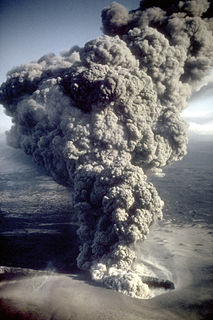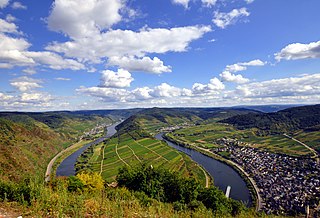Bernkastel-Wittlich is a district in Rhineland-Palatinate, Germany. It is bounded by the districts of Vulkaneifel, Cochem-Zell, Rhein-Hunsrück, Birkenfeld, Trier-Saarburg and Bitburg-Prüm.
Vulkaneifel is a district (Kreis) in the northwest of the state Rhineland-Palatinate, Germany. It is the least densely populated district in the state and the fourth most sparsely populated district in Germany. The administrative centre of the district is in Daun. Neighboring districts are Euskirchen, Ahrweiler, Mayen-Koblenz, Cochem-Zell, Bernkastel-Wittlich, and Bitburg-Prüm.

A maar is a broad, low-relief volcanic crater caused by a phreatomagmatic eruption. A maar characteristically fills with water to form a relatively shallow crater lake which may also be called a maar. The name comes from a Moselle Franconian dialect word used for the circular lakes of the Daun area of Germany. Maars are shallow, flat-floored craters that scientists interpret as having formed above diatremes as a result of a violent expansion of magmatic gas or steam; deep erosion of a maar presumably would expose a diatreme. Maars range in size from 60 to 8,000 m across and from 10 to 200 m deep; most maars commonly fill with water to form natural lakes. Most maars have low rims composed of a mixture of loose fragments of volcanic rocks and rocks torn from the walls of the diatreme.

Manderscheid is a town in the Bernkastel-Wittlich district in Rhineland-Palatinate, Germany, and also both a climatic spa and a Kneipp spa. Until 1 July 2014, when it became part of the Verbandsgemeinde Wittlich-Land, it was the seat of the former Verbandsgemeinde Manderscheid.

Bettenfeld is an Ortsgemeinde – a municipality belonging to a Verbandsgemeinde, a kind of collective municipality – in the Bernkastel-Wittlich district in Rhineland-Palatinate, Germany.

Musweiler is an Ortsgemeinde – a municipality belonging to a Verbandsgemeinde, a kind of collective municipality – in the Bernkastel-Wittlich district in Rhineland-Palatinate, Germany.

Pantenburg is an Ortsgemeinde – a municipality belonging to a Verbandsgemeinde, a kind of collective municipality – in the Bernkastel-Wittlich district in Rhineland-Palatinate, Germany.

The Volcanic Eifel or Vulkan Eifel is a region in the Eifel Mountains in Germany, that is defined to a large extent by its volcanic geological history. Characteristic of this volcanic field are its typical explosion crater lakes or maars, and numerous other signs of volcanic activity such as volcanic tuffs, lava streams and volcanic craters like the Laacher See. The Volcanic Eifel is still volcanically active today. One sign of this activity is the escaping gases, for example, in the Laacher See.

The Weinfelder Maar, also called the Totenmaar, is a maar around two kilometres southeast of the town of Daun in the Eifel Mountains, in the German state of Rhineland-Palatinate.

The Idar Forest is part of the Hunsrück low mountain range in the German federal state of Rhineland-Palatinate, Germany.

The Moselle Hills form a ridge, up to 434.1 m above sea level (NHN), on the left bank of the River Moselle between Reil and Schweich in the Rhineland-Palatinate counties of Bernkastel-Wittlich and Trier-Saarburg. There are vineyards on the southern slopes of the wooded hills. They lie on the southern edge of the Eifel region.

The Kondelwald, also known as the Kondel, is a forest, about 2,500 hectares in area and up to 477.5 m above sea level (NHN), that forms part of the Moselle Eifel. It lies within the counties of Bernkastel-Wittlich and Cochem-Zell in the German state of Rhineland-Palatinate. It used to belong to the imperial Carolingian estate of Kröver Reich.

The Idarkopf near Stipshausen in the Hunsrück is a mountain, 745.7 m above sea level (NHN), within the Idar Forest in the German counties of Birkenfeld and Bernkastel-Wittlich. It is one of the highest mountains in the state of Rhineland-Palatinate.

The Volcanic Eifel Nature Park lies in the counties of Bernkastel-Wittlich, Cochem-Zell and Vulkaneifel in the German state of Rhineland-Palatinate. The nature park, which is in the Eifel mountains, and which is also a geopark, was inaugurated on 31 May 2010 and has an area of 1,068.24 km².> Its sponsor is the Natur- und Geopark Vulkaneifel GmbH.

The Kellerberg is a hill, 448.8 m above sea level (NHN), and the highest point of the Eifel part of the Meulenwald and of the collective municipality of Wittlich-Land. It rises near Dierscheid in the county of Bernkastel-Wittlich in the German state of Rhineland-Palatinate. At the top is the Kellerberg Observation Tower.

The Little Kyll German: Kleine Kyll, pronounced: "kill") is a 23.9-kilometre-long orographically right-hand tributary of the Lieser.

The Meulenwald, also called the Mühlenwald, is a bunter sandstone hill ridge, up to 448.8 m above sea level (NHN), in the southern part of the Eifel mountains in the counties of Trier-Saarburg and Bernkastel-Wittlich in the German state of Rhineland-Palatinate.

The Moselle Eifel forms the southeastern strip of the East Eifel to the left of the Moselle from the city of Trier downstream as far as Moselkern; in the southeast it does not reach as far as the Moselle Valley. It lies exclusively within the German state of Rhineland-Palatinate and is a truncated highland, roughly half of which is forested.

The Heidenköpfe (plural) are a group of three summits near Dahlem in Germany that are about 595 m above sea level (NHN). They lie within the mountain region of North Eifel in the counties of Euskirchen and Vulkaneifel in the states of North Rhine-Westphalia (NW) and Rhineland-Palatinate (RP).

The Rockeskyller Kopf near Rockeskyll in the county of Vulkaneifel in the German state of Rhineland-Palatinate is a hill, 554.6 m above sea level (NHN), in the Eifel mountains. It is an extinct volcano complex from the Quaternary period, around 360,000 years old and is designated as a natural monument (ND-7233-420).















